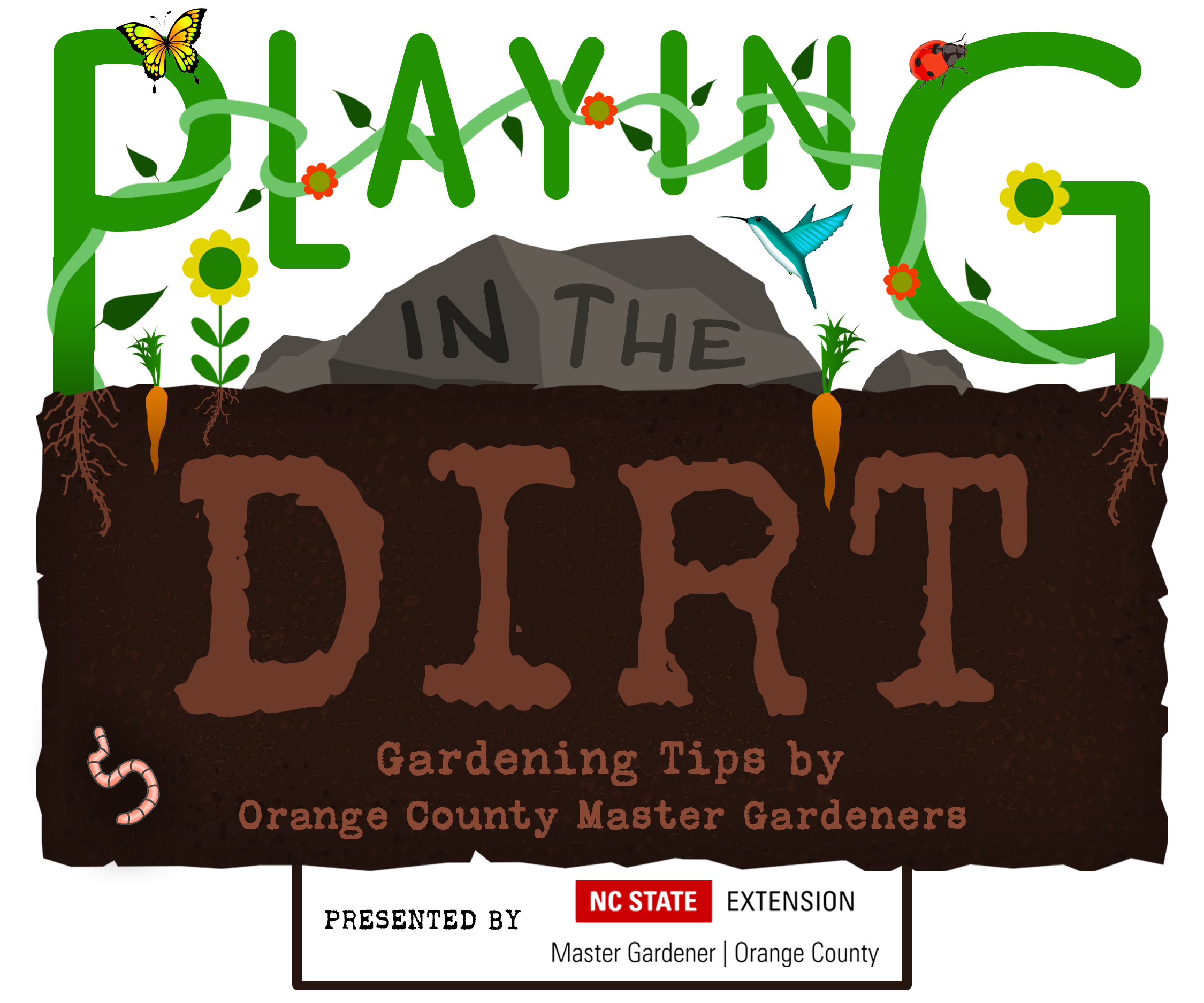
97.9 The Hill and Chapelboro.com have partnered with NC State Extension Master Gardener℠ volunteers of Orange County for “Playing in the Dirt,” a monthly column providing information and inspiration to gardeners of all skill levels! Check back on Chapelboro each month for a new subject – from our gardens to yours!
By Lynn Calder, Orange County Master Gardener℠ volunteer
Spring officially arrived in April, along with National Native Plant Month, Earth Day and the Town of Hillsborough’s first ever “Climate Challenge”! We hope you’ve been inspired to take steps right now to help promote ecological biodiversity and restore ecosystems — even in your own backyard. Resources to help you are listed at the end of this article.
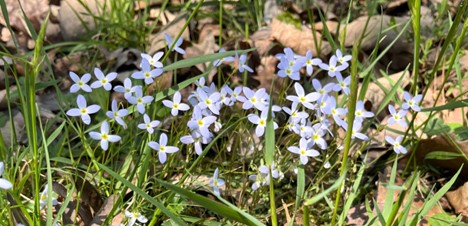
Native wildflower, azure bluet (Houstonia caerulea). Photo by Lynn Calder.
Biodiversity is Necessary for Life
We must have biodiversity to live. The air we breathe, water we drink and food we eat all rely on ecosystems of various plants, animals, fungi, algae and microorganisms. Without biodiversity, ecosystems are more vulnerable to failure.
Our increasing population and lifestyle choices, however, have caused an alarming loss of natural areas and decline in biodiversity of plant and animal life. Decades of accelerated population growth have resulted in enormous cities and sprawling suburban development. We’ve used pesticides and weedkillers to produce bug-free and weed-free yards that we’ve landscaped with manicured lawns and non-native ornamental trees, shrubs and flowers. Some of the non-natives we’ve introduced have become aggressive invasive plants that outcompete native plants.

Native wildflower, lyreleaf sage (Salvia lyrata), can tolerate mowing so may be a lawn alternative. Photo by Lynn Calder.
There is good news, however! Every gardener can help regenerate our lost biodiversity and increase sustainable ecosystems that will support pollinators and other insects, birds, and wildlife. One key to regeneration is planting more native plants. As you’re choosing new plants for your spring and summer gardens — whether for landscaping large areas around your home, adding to existing plantings or filling containers on your patio, deck or balcony — choose native trees, shrubs, perennials, grasses and groundcovers. Look how a Briar Chapel homeowner transformed her tiny 1,000-square-foot yard with natives and inspired neighbors!

Red Buckeye (Aesculus pavia) is a small, native tree or shrub growing 15 to 25 feet tall. Tubular red flower clusters in spring; seeds are inedible by humans. Photo by Lynn Calder.
Why Are Native Plants So Important for Biodiversity?
Plants turn sunlight into the food that supports the rest of all life. Insects and other animals either eat plants directly or eat something that has eaten a plant. Because insects provide food for most animals that don’t eat plants themselves, insects must thrive for all other life to thrive. This is where the importance of native plants enters the picture.
About 90% of the insect species that eat plants to live can only eat one or two particular kinds of plants with which they co-evolved — certain native plants. Further, while bees, butterflies and moths (and other pollinators like beetles and flies) may visit non-native plant flowers for pollen or nectar, native plants are more attractive to pollinators and certain natives are necessary as host plants for their eggs. Insects depend on native plants (don’t forget trees) for food and nesting habitats and non-plant eating animals ultimately depend on insects for their food and survival.
How our backyard birds need insects to survive is a good example of the native plant-to-insect-to-wildlife food chain. Butterflies and moths lay eggs on or near native larval host plants that provide leaves (or other parts) for the hatching caterpillars to eat. The caterpillars will only eat the host plant and will not move to another plant even if they run out of food. While some of the caterpillars will grow and transform into adults, many will be eaten by birds, frogs and other insects.
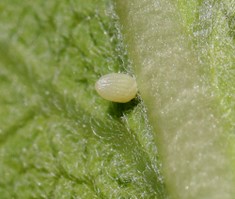
Monarch egg and caterpillar on common milkweed (Asclepias syriaca), the monarch’s only larval host plant.
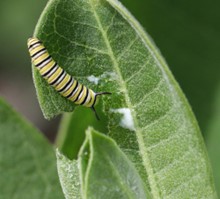
Photos by Debbie Roos.
Ninety-six percent of North American bird species rely on caterpillars, other insects and other arthropods to feed their young. Certain kinds of birds need an enormous number of caterpillars to feed babies. For example, up to 9,000 caterpillars are needed for a single family of chickadees (that’s 350 to 570 a day!). Bird feeders help feed adult birds in winter but baby birds need caterpillars to survive. Similarly, though hummingbirds (also pollinators) visit flowers and feeders for nectar, much of their diet consists of protein-rich insects and spiders. Non-migrating birds that eat seeds and berries in winter also need insects for nutrition in spring and summer. Without native plants to host larvae and provide food for plant-eating insects, these birds will not have adequate food for themselves or their young.
Gardening With Natives
University of Delaware entomologist and wildlife ecologist Doug Tallamy advises that to give animals a chance to survive, we have to change gardening practices that have focused on growing lush lawns and non-native plants and getting rid of all the insects. Instead, we need to design gardens with an ecological purpose in mind and replace at least part of our lawns with densely planted native plants.
Add native plants that bloom at different times of the year to give pollinators the nectar and pollen they need as food, and also use a mix of nectar and larval host plants. Adding even a few native plantings, and refraining from using pesticides, will help repopulate insects thereby increasing bird and other wildlife species.
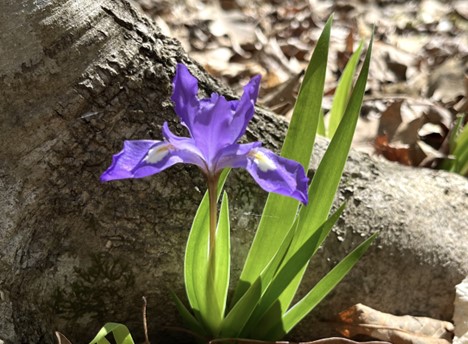
Dwarf crested iris (Iris cristata) can spread to form a groundcover in partly shady woodland sites. Photo by Lynn Calder.
If you can do more, incorporate layers of native large and small trees, shrubs, grasses, perennial flowers, vines and ground covers. In fact, while all native trees contribute to biodiversity, native oak trees are one of largest contributors in the plant world — they can provide food, shelter and breeding habitat for over 2,000 wildlife species, about 300 of which are only found on oaks.
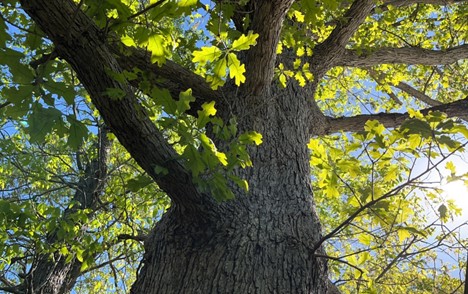
Native white oak (Quercus alba). Photo by Lynn Calder.
In a previous Playing in the Dirt article, Orange County Extension Master Gardener volunteer Faye McNaull, suggested additional ways that gardeners can attract and sustain wildlife. Add a water source, like a dish, bird bath or small pond, and landing surfaces, to support insects and birds. Change the water every few days to avoid breeding mosquitoes. Avoid using chemical pesticides and herbicides; prevent damage from pests, if necessary, through identification and close observation and early removal by non-chemical methods.
The Town of Hillsborough Supports Natives
Did you know that in 2019, the Town of Hillsborough adopted an ordinance to encourage natural landscaping? The ordinance “allows property owners to convert lawns to managed landscape areas, which provide habitat for pollinators and other wildlife and reduce greenhouse gas emissions by reducing mowing” (click on Managed natural landscapes here). To illustrate how different types of natural landscapes can be achieved, Orange County Master Gardener volunteers created this instructional video: Add Native Plants to Your Yard.
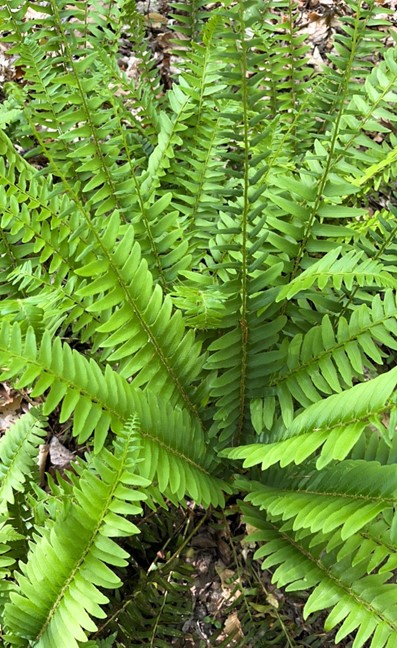
Christmas Ferns (Polystichum acrostichoides) provide low winter cover for songbirds and help combat soil erosion on shady slopes. Photo by Lynn Calder.
There are many great resources on biodiversity, sustainable ecosystems, and native plants. Here are a few to check out:
Resource List for Pollinator Conservation (NC State Extension)
Includes books and publications, supplies, native plant and seed suppliers, and supporting organizations
North Carolina Pollinator Toolkit (North Carolina Botanical Garden, UNC 2019)
Extensive information on planting, maintenance, sourcing, funding, etc.
Managing Native Plant Landscapes: Access, Design, Install, Manage Manual (New Hope Audubon)
Manual and webpage with links to:
- Using Native Plants (including recommended sources for plants)
- Mobile Friendly List of Plant Recommendations for the Piedmont
- Removing Invasive Plants and Invasive Species List
- Why You Should Leave Your Leaves (and how to get a sign)
- Ways to Make Habitat Safe and Friendly for Wildlife
- Bird Friendly Habitat Certification
North Carolina Wildlife Federation List of NC Native Plants
Includes photos and descriptions of plants
Creating Your Pollinator Garden (NC Botanical Garden)
Brochure with quick tips
Pollinator Gardens (University of Maryland Extension)
Helping Pollinators in Small Green Spaces (including balconies and porches) (University of Maryland Extension)
Books by Douglas W. Tallamy:
- Bringing Nature Home: How You Can Sustain Wildlife With Native Plants (2009)
- Nature’s Best Hope: A New Approach to Conservation That Starts in Your Yard (2020)
- The Nature of Oaks (2021)
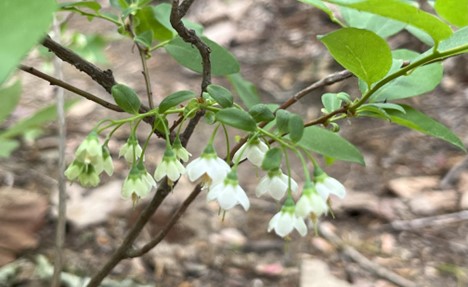
Deerberry (Vaccinium stamineum) is a native shrub from 5 to 15 feet tall and wide. Photo by Lynn Calder.
A few additional organizations:
Non-profit organization that promotes environmentally sound landscaping practices through education, advocacy and collaborative action. Publishes quarterly online journal; chapters nationwide. Wild Ones Carolina Triangle Chapter
North Carolina Native Plant Society (8 chapters including Triangle)
Homegrown National Park Project
Co-founded by Doug Tallamy, a cooperative conservation movement to mobilize anyone with any amount of soil available (pots, lawns, woods, farms, etc.) to plant and preserve native species and remove invasives. Interactive community-based map where growers post their native plantings toward a goal of 20 million acres of native plantings across the U.S. on private land to create interconnected ecological networks outside of parks and preserves.
Homegrown National Park Keystone Container Gardens Project
Regional guides of keystone native plants that can thrive in containers (balconies, patios, decks rooftops) and in the ground.
More about Orange County Master Gardener Volunteers:
- Have a plant or garden question? Email the Orange County Master Gardener volunteers at ocmgardeners@gmail.com or phone 919-245-2061.
- Subscribe to The Garden Buzz, the Orange County Master Gardeners’ monthly newsletter, for gardening news and tips. And visit our website, The Orange Gardener, for helpful gardening information and tips.
- Follow us on Facebook! Our page is Orange County NC Extension Master Gardener Volunteer.
Train to be a Master Gardener Volunteer:
Interested in becoming a Master Gardener volunteer in Orange County? We help people in our county learn about plants and gardening, using research-based information.
Applications are due May 31, 2024, for a training class for new volunteers that starts in September 2024. Prior to filling out an application, candidates must participate in an orientation to better understand what our program is about; the last orientation scheduled is May 8, 6-7:30 p.m. Click here for more information and to sign up for the orientation.
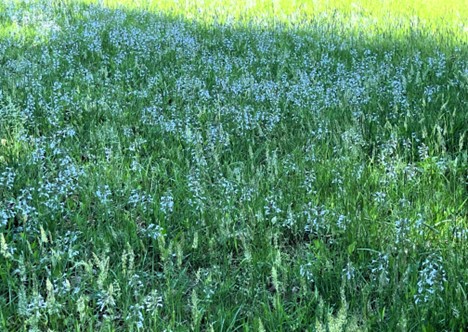
Field of lyreleaf sage. Photo by Lynn Calder.
Chapelboro.com does not charge subscription fees, and you can directly support our efforts in local journalism here. Want more of what you see on Chapelboro? Let us bring free local news and community information to you by signing up for our newsletter.

